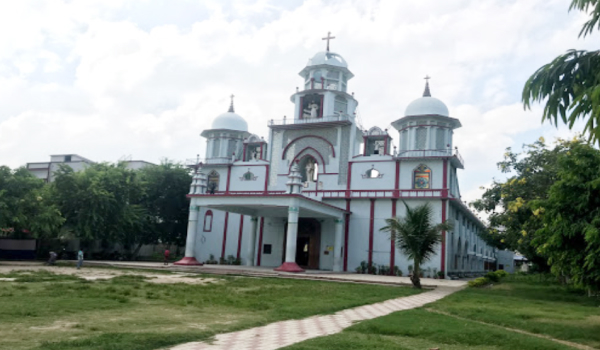
The archdiocese of Patna is spread over 37,119 square kilometres and comprises civil districts of Patna, Nalanda, Nawada, Gaya, Aurangabad, Rohtas, Jehanabad, Bhojpur, Bhabhua, Buxar, Sheikhpura, and part of Munger and Jamui of Bihar state.
In 2016, the total population of the archdiocese was 34,991,000. There is virtually no tribal population in the territory except for some Santhals. But Mushahars, a semi tribal fraternity, are in large numbers. The majority of the population comprises non-tribal Hindus, Muslims, Catholics, Buddhists, Sikhs and Jains. The uniqueness of the archdiocese is that it contains the holiest shrines of Buddhists and Jains. Bodh Gaya is the place where Lord Buddha had attained enlightenment some 2,600 years ago. Rajgir is another Buddhist pilgrimage. Pawapuri is the place where Lord Mahavira, the founder of Jainism, attained enlightenment. Even Rajgir is a Jain center of pilgrimage. Patna Saheb in Patna is the place where one of the founders of Sikhism, Guru Govind Singh, was born. Gaya is one of the holiest Hindu place where Hindus come to offer prayers for the liberation of the souls of their ancestors.
Bhojpuri, Magahi and Hindi are the major languages in use in the archdiocesan territory. But even English, Urdu and Santhali languages are also used.
The seed of Patna archdiocese was initially sown in 1703 when the Congregation for the Propagation of Faith erected the prefecture of Tibet Hindustan and entrusted it to the Capuchin fathers of the Italian province of Pinenum in the Marches of Ancoa. The first group of missionaries reached Lhasa (Tibet) in 1707 and began a mission station there. For nearly 41 years, the Capuchin missionaries worked in Lhasa until a religious persecution forced them to give up their mission and move to Kathmandu (Nepal) in 1745.
The Capuchin missionaries had varying success in Kathmandu since 1715. A new conqueror of the Kathmandu valley, Raja Pritvi Narayan Shah, who was not sympathetic to the missionaries, stopped all support to them. The Nepal mission was also abandoned in 1769, and the missionaries with 62 Nepalese Christians and five catechumens moved to India. They settled down at Chuhari near Bettiah. The scene of the Capuchin mission shifted now to the Indian soil.
Father Joseph Mary, OFM Cap., founded the Bettiah mission in 1745, after the King of Bettiah, Raja Druva Singh, had obtained permission for the same from Pope Benedict XIV.
Rome elevated the prefecture of Tibet-Hindustan to a vicariate in 1812. In 1827, an independent Patna vicariate was created, comprising Bettiah, Chuhari, Patna City, Danapur, Bhagalpur, Darjeeling, Sikkim, Nepal and adjacent territories. Father Anastasius Hartmann, OFM Cap., was appointed its first apostolic vicar.
Patna vicariate became a part of Allahabad diocese in 1886. The North Bihar mission with its four stations of Bettiah, Chuhari, Chakhani and Latonah was entrusted to the Tyrolese Capuchins in 1886. In May 1892, the North Bihar mission was made Bettiah-Nepal prefecture with Father Hilanon of Abtei, OFM Cap. as its first prefect. In 1919, this prefecture was dissolved and grouped to South Bihar to form the present archdiocese of Patna.
On Sept. 10, 1919, Pope Benedict XV divided the diocese of Allahabad into two. The diocese of Patna was thus created. The prefecture of Bettiah-Nepal was annexed to the new diocese. The Holy See entrusted Patna diocese to American Missouri province of the Society of Jesus. Later, on Nov. 13, 1930, after the division of Missouri province, Patna diocese was entrusted to the Chicago province of the Society of Jesus. Louis Van Hoeck, S.J., was ordained the first bishop of Patna on March 1921.
On March 28, 1980, Pope John Paul II accepted the resignation of Bishop Augustine Wildermuth, S.J., and divided the Patna diocese into two units, Patna and Muzaffarpur. Father Benedict John Osta, S.J., was appointed bishop of Patna, and Father John Baptist Thakur, S.J., as bishop of Muzaffarpur. The Patna diocese was subsequently declared archdiocese in 1999 and Bishop Osta, S.J., became its first archbishop.
The per capita income in the archdiocesan territory is Rs 4,097 ($90). The region is extremely drought-prone affecting agriculture to a great extent. Paddy, maize, and vegetables are the major agricultural produces. Sugarcane is also produced. Fishery around the Ganges River is an important economic activity of the region. Except for a few, industries are virtually absent in the region. Most working adults are migrant laborers. Most of the areas of the archdiocese suffer from outlawed Maoist violence.
The archdiocese is located in the northern part of Bihar state having its headquarters in Muzaffarpur which is also the headquarters of the civil district of Muzaffarpur. The archdiocese shares a 100-kilometer-long border with Nepal in the north. It borders the diocese of Purnea in the east, the diocese of Bettiah in the west and the Ganges River in the south.